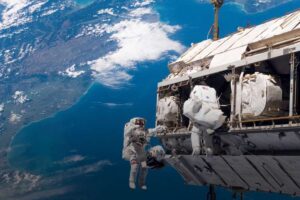UPSC Relevance
GS-3: Science and Technology – Indian scientific achievements, technology indigenization
GS-2: International Relations – India’s space mission collaborations
Essay & Ethics – Risk management, human-focused science policy

Key Highlights
Safety in Human Spaceflight
The safe return of NASA astronauts Sunita Williams and Barry Wilmore from the ISS highlights rigorous safety protocols. As ISRO gears up for Gaganyaan, safety across all phases—launch to re-entry—is paramount, drawing on global standards.
Launch Emergency Protocols
Gaganyaan’s crew escape system (CES), mounted above the module, differs from satellite launch vehicles. In emergencies, the CES ejects the module with high thrust to a safe distance, followed by parachute-assisted sea splashdown.
Abort Mechanisms
Multiple abort scenarios are planned, depending on the timing of malfunctions:
- Pre-liftoff
- Post-ignition but pre-launch
- During ascent
Launch Vehicle Specifications
Gaganyaan will use a modified LVM3, designed for high reliability and abort safety. A solid fuel-powered CES allows millisecond-fast astronaut ejection if needed.
Space Safety Procedures
In Orbit
Though Gaganyaan won’t dock with a space station, crew training includes:
- Stabilizing spacecraft orientation
- Operating thrusters
- Managing emergencies
Space Station Training
Astronauts learn:
- Tethering techniques
- Docking procedures
- Navigating zero-gravity environments
- Handling threats like debris, fire, or toxic leaks
Re-entry Phase
The riskiest stage, mitigated by heat shields (enduring up to 1,800°C).
Parachutes slow the spacecraft from 750 m/s to 10 m/s for splashdown.
Similar protocols are used by NASA, SpaceX, and Blue Origin.
Lessons from History
Since the 1960s, 17 astronauts and 4 cosmonauts have perished in spaceflight accidents, including:
- Apollo 1 fire (1967)
- Challenger explosion (1986)
- Columbia disintegration (2003)
Significance
Gaganyaan, India’s first crewed mission, requires flawless safety measures.
Adopting ISS and NASA standards ensures global compliance.
Showcases India’s advancements in human-rated launch vehicles.
Analysis & Way Forward
ISRO emphasizes redundant safety systems, abort protocols, and international best practices. Continuous training, simulations, and global partnerships are vital for India’s human space exploration goals. Post-Gaganyaan, ISRO could develop its own space station or join global crewed missions.




